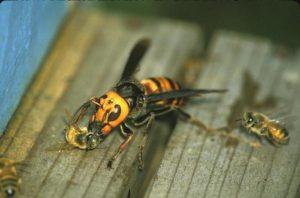How does the hornet queen live and what does she do
Hornets are part of the wild. This is the largest variety of wasps. The head of the family is the queen or queen. Its function is to establish a colony. She devotes the entire cycle of her life to producing offspring.
Content
Description of the hornet's uterus
The structure and color of the uterus is almost the same as that of the rest of the hornets. The body has yellow, brown, black stripes. The eyes are red.
The body is covered with hairs. Powerful jaws help to tear apart prey. Prey include caterpillars, bees, butterflies. A large individual feeds on birds and frogs.
The size reaches 3,5 cm. This is 1,5 cm more than other representatives. The size of the uterus of a tropical species can be 5,5 cm.
Life cycle
The life of a queen is 1 year. During this period, it gives several hundred lives.
The female keeps the sperm in a separate reservoir due to the fact that cold weather is ahead and it will be necessary to look for a place to hide.
The life cycle consists of:
- exit from the larva;
- mating;
- wintering;
- constructions of honeycombs and laying of larvae;
- reproduction of offspring;
- death.
Queen's wintering
In autumn, in warm weather, the queen stocks up on reserves for the winter. In November, almost all working individuals perish, and the nest becomes empty. The nest is not used twice. The young queen is looking for a suitable place for a new home.
Habitat in winter - hollow, tree bark, crevices of sheds. Not every individual is able to survive in cold weather and produce a new colony.
In the state of diapause, the accumulated nutrients are economically consumed. Diapause contributes to the inhibition of metabolism. During this period, there is a decrease in temperature and a reduction in daylight hours. The body becomes more resistant to external influences.
However, other threats remain. Birds and mammals eat them. If the shelter is a nest that has already been used, then the queen may not survive until spring. There is a chance of contracting a tick-borne or bacterial infection. Tropical queens do not hibernate.
Formation of a new colony
- In the spring, the female wakes up. She needs food to restore her strength. The diet consists of other insects. When fruits appear, the food becomes more varied.
- Fromthe queen is capable of destroying a whole hive of wasps or bees. Matka flies and scouts the territory. Hollows, burrows in the field, places under roofs, birdhouses can be a new habitat.
- The queen collects soft bark, chewing it afterwards. This is the material for the first hexagonal honeycombs. The queen works independently and makes a nest. The number of cells reaches 50 pieces. The uterus lays eggs and determines the sex of future individuals.
Fertilized eggs contain females, while unfertilized eggs contain worker hornets.
It is worth noting that certain conditions affect reproduction. The death of the uterus leads to the activation of the ovaries in normal females. Under normal conditions, they are suppressed by the queen's pheromones. Such eggs are always unfertilized, as there was no mating. Of these, only males appear.
However, without young females, the colony declines. A week later, larvae appear in size from 1 to 2 mm. The mother feeds her offspring by hunting insects. Until July, 10 working individuals live in the nest on average. The queen rarely flies.
Building a nest
The role of the main builder belongs to the young uterus. The design has up to 7 tiers. The building expands downwards when the lower tier is attached.
Conclusion
The uterus is the center and basis of a large colony. She makes a huge contribution to the formation of a new family. The queen builds a nest and produces offspring until her death. She also manages all workers. Its role is fundamental in the life cycle of insects.
Previous
